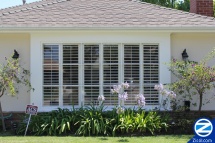Bow Windows
 | |
| Other Names: | |
|---|---|
| Bow Windows Replacement | |
| Description: | |
| Outward projecting group of four or more windows arranged in an arch. |
Bow windows are an attractive choice for homeowners who want to replace their existing windows while creating an expansive room design. The outward projection of a bow window, a grouping of four attached windows arranged in an arc, can serve as the focal point of a room by creating bringing the outdoors into the room.
Contents |
[edit] Bow Windows
The bow window replacement option is an appealing architectural choice for homeowners who are looking for ways to catch more natural light in a room. The window's multiple dimensions add a utilitarian service to the indoor. Bow windows are assembled from four attached windows which are joined in 30°, 45°, 60° or 90° degree angles. The resulting arc projects the window outside and, for specific bow window sizes, offers the opportunity to install a seat or shelf in the empty space within the arc. Bow windows are available in all sizes and shapes.
[edit] Considerations
Many architects include a bow window or a group of bow windows in a plan for a remodeled house. A bow window presents a stylish design that will increase the home's appearance both inside and out. The bow window is an attractive and functional addition to any room. Homeowners should review their budget when considering a bow window because these windows present a more expensive window option than standard windows. In addition, while bow windows allow for an increased flow of air and light into a room they also open the room to increased exposure from the sun. Many architects and window manufacturers suggest that a protective sunblock be taken into account when calculating a window's cost.
[edit] Types of Bow Windows
Bow windows are an assembly of four or more windows whose angles allow the window to project outward. A replacement bow window can be comprised of four operable windows, four non-operable windows or any combination thereof. Homeowners may create a bow window by placing two block glass windows between two-operable windows or two operable windows between two block glass windows. Operable windows for a bow window generally include single-hung, double-hung or casement windows.
Bow window combinations may include an added operable awning or non-operable block glass window which is placed either above or below the bow window assembly.
[edit] Sizes and Shapes
Replacement bow windows bring light and ventilation into a room and create an elegant look for both the window's interior and exterior appearance. Homeowners and designers can create any desired architectural style by planning the replacement bow window assembly in a way that the component windows converge to suit the available space and existing room design. A home design can place a small bow window above a kitchen sink, over a desk unit in a study or above a family viewing center in the den or living room. Larger bow windows, including floor to ceiling bow windows are appropriate replacement window additions for a dining room, living room or an enclosed porch or patio.
All of these placements add sunlight and, with operable windows, ventilation to a room.
[edit] Placement
Homeowners must review a wall's rough opening when determining which size, shape and component windows will provide the best replacement bow window for a particular situation. Window installers can assemble a bow window in 30°, 45°, 60° or 90° degree angles to present a range of bow window compilation options. The bow window can be constructed as a box window, in a semi-circular arc or even in a 60° triangular shape.
The size and shape of a replacement bow window is dependent on the available light and ventilation as well as the room's size and the general window plan for the room. Replacement bow windows can be assembled using long rectangular windows, short wide windows or any suitable window combination that fits the wall's rough opening. Bow window alternatives include two smaller middle windows flanked by two larger windows, two large middle windows flanked by two smaller windows, two sets of double windows that meet at a 60° triangular angle and more.
[edit] Glazing Options
The large amount of exposed glass in a replacement bow window necessitates careful glazing arrangements. Insulated glass and anti-sun coatings are available to cut down on the sun's rays and provide easier insulating capabilities.
Each window manufacturer features their own glazing alternatives including options for single-pane glazing, double-pane glazing and, for replacement bow windows in extreme climates, triple-pane glazing. Many manufacturers insulate their multi-pane windows by pumping argon or krypton gases in between the panes to help maintain the room's internal temperature. The manufacturer then seals the panes into the window's sash to eliminate any possibilities of escaping gas. Multi-pane glass options also help block noise pollution.
Another energy-efficient glazing option is the addition of a Low-E -- low emissivity -- coating which can be applied to the glass on the replacement bow window before the window leaves the factory. Low-E coating suppresses radiative heat flow and blocks the sun's rays. Homeowners should investigate the glazing options available with each type of framing to ensure that they receive the most cost-efficient glazing alternative.
Multi-pane bow windows, insulated windows and windows with anti-sun coating are generally a more expensive window option than non-energy-efficient windows. However, the resulting savings in energy costs combined with available rebates for environmental home renovation projects make such windows an economical window choice over the long term. Homeowners can check with their state's Department of Energy to ascertain the rebates available for purchase of energy-efficient windows.
Replacement bow windows are also available with single-pane glazing, providing an inexpensive bow window option for windows that do not absorb direct sunlight.
[edit] Framing Material
Replacement bow windows come in a variety of framing materials including low-cost vinyl and aluminum as well as higher-priced fiberglass and aluminum-clad. Wood windows are also available but the homeowner must prepare to paint or varnish the windows annually to prevent rotting and warping.
Among the less-expensive bow window framing materials are aluminum windows which are available in a variety of colors. Aluminum windows do not require maintenance after installation but the material causes condensation in cold weather, adding to the moisture level in the home. Vinyl bay windows are also a low-maintenance replacement window option which provides adequate insulation. The window installer must carefully insulate the window sash and frame cavities.
More costly bow window alternatives include fiberglass frames and clad wood frames. Fiberglass frames are strong and durable and insulate well. Aluminum clad frames provide a sturdy treated aluminum cladding which the window manufacturer attaches to the wood frame in the factory. These windows are generally double-paned windows which, in conjunction with the framing material provide good insulation and a frame which is resilient to weather extremes.
[edit] Accessories
Accessories for replacement bow windows include interior trim, grilles and screens. Screens are a standard accessory for operable windows. Clip-in screens can be easily removed to allow for easier cleaning.
Grilles are also available as a clip-on option from many window manufacturers. In addition, manufacturers of multi-pane replacement bow windows can install a grille in between the glass panes in the factory for a clean look and easy cleaning.
Homeowners can select the interior trim that suits their room design. These interior moldings are available from window manufacturers, lumber yards, home centers and hardware stores.
| ||||||||||||||

